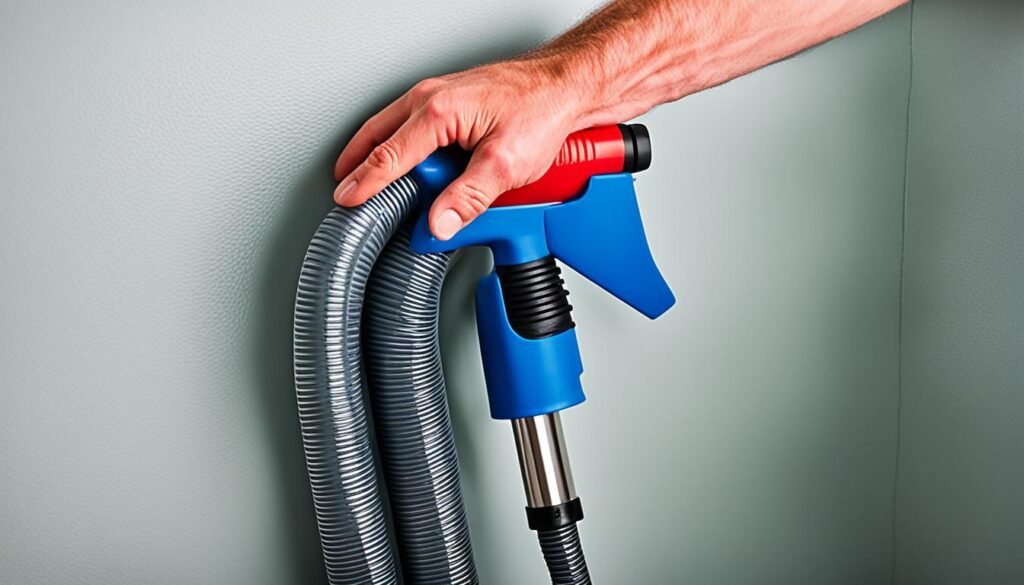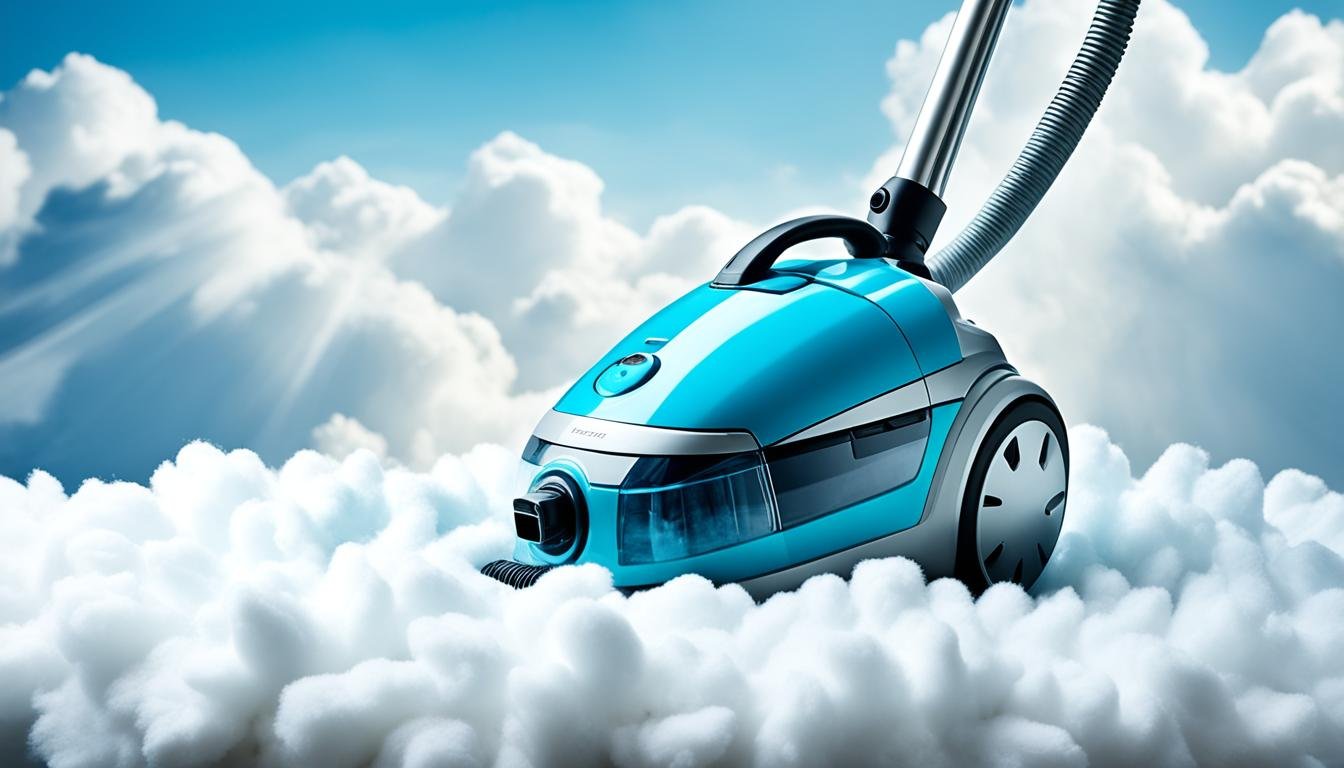To keep your vacuum cleaner in optimal condition and maximize its performance, regular maintenance is key. If you find that your vacuum is becoming hard to push or the noise is too loud, there are several effective methods and techniques to soften your vacuum cleaner. By following these tips, you can ensure a quieter and more efficient cleaning experience.
Key Takeaways:
- Regular maintenance is essential for keeping your vacuum cleaner in optimal condition.
- Check the height settings to ensure proper performance on different types of flooring.
- Inspect the rotator brush and wheels for any issues that may affect the vacuum’s ease of use.
- If necessary, replace the brush belt to restore the rotation of the brush.
- Perform regular hose maintenance to keep the vacuum functioning effectively.
Check Height Settings and Inspect Rotator Brush and Wheels
One common reason for a vacuum cleaner being hard to push is incorrect height settings. It’s important to check and adjust the height setting according to the type of flooring you are vacuuming. For instance, using a low height setting on shag carpet can impede the brush’s rotation and airflow, making it harder to push the vacuum cleaner. By ensuring the height setting is appropriate for your specific flooring, you can alleviate the resistance and make your vacuum easier to maneuver.
In addition to checking the height settings, it’s also essential to inspect the rotator brush and wheels of your vacuum cleaner. Over time, hair, fibers, and other debris can get tangled in the brush or accumulate around the wheels, causing them to become less effective and increasing the effort required to push the vacuum. Regularly inspecting and cleaning these components will help maintain optimal performance and ensure a smoother cleaning experience.
Inspecting the rotator brush involves checking for any tangled hair or debris and carefully removing it. You can use a pair of scissors or a brush cleaning tool to gently remove any obstructions. Additionally, examining the wheels is crucial to ensure they are clean and free from any blockages that might hinder their movement. By performing these inspections regularly, you can prevent excess strain on the vacuum cleaner and keep it functioning at its best.
Replace the Brush Belt and Perform Hose Maintenance
If your vacuum cleaner is still hard to push after checking the height settings and inspecting the brush and wheels, it may be necessary to replace the brush belt. A worn-out or broken brush belt can cause the brush to stop rotating, resulting in increased effort required to push the vacuum. Refer to your vacuum’s manual or manufacturer’s website for specific instructions on how to replace the brush belt.
Additionally, regular hose maintenance is essential for maintaining optimal suction power and ensuring a soft and efficient vacuuming experience. Over time, hoses can become clogged with debris, affecting the vacuum’s performance. To prevent this, periodically check and clean the hose for any blockages. Use a long, flexible brush or a straightened wire hanger to remove any obstructions. Be gentle and avoid using sharp objects to prevent damage to the hose.
Remember, brush belt replacement and proper hose maintenance are crucial steps in softening your vacuum cleaner and improving its overall performance.

Conclusion
Keeping your vacuum cleaner soft and functioning efficiently is crucial for effective cleaning. By implementing the tips and techniques shared in this article, including checking height settings, inspecting the rotator brush and wheels, replacing the brush belt, and conducting regular hose maintenance, you can ensure optimal performance and enjoy a quiet and hassle-free cleaning experience.
Make these practices a part of your routine vacuum cleaning regimen to preserve the condition of your carpets and floors for years to come. By maintaining a soft vacuum cleaner, you can achieve thorough and effective cleaning results without straining yourself or experiencing excessive noise. Follow these best practices and enjoy a smoother and quieter cleaning experience with your vacuum cleaner.
Remember, regular maintenance is key to keeping your vacuum in top shape. By taking care of your machine, you can prolong its lifespan and maximize its cleaning power. So take the time to implement these softening techniques and enjoy the benefits of a well-maintained vacuum cleaner in your home.
FAQ
How can I soften my vacuum cleaner?
To soften your vacuum cleaner, you can follow these effective methods and techniques: check height settings, inspect rotator brush and wheels, replace the brush belt, and perform regular hose maintenance. These steps will help maintain your vacuum’s performance and provide a quieter cleaning experience.
Why is my vacuum cleaner hard to push?
One common reason for a vacuum cleaner being hard to push is incorrect height settings. Make sure you are using the appropriate setting for the type of flooring you are vacuuming. Additionally, a worn-out or broken brush belt can cause the brush to stop rotating, making it harder to push the vacuum. Inspecting the rotator brush and wheels can also help identify any issues causing difficulty in pushing the vacuum.
How do I check the height settings on my vacuum cleaner?
Refer to your vacuum’s manual or manufacturer’s website for specific instructions on how to check and adjust the height settings. Different vacuums may have different methods for adjusting the height. The correct height setting ensures optimal cleaning performance and ease of pushing the vacuum on different types of flooring.
How do I inspect the rotator brush and wheels?
To inspect the rotator brush and wheels, start by turning off and unplugging the vacuum. Look for any tangled debris or hair wrapped around the brush or wheels. Use a pair of scissors or a brush to gently remove any obstructions. Make sure the brush spins freely and the wheels move smoothly without any excessive noise or resistance.
How do I replace the brush belt on my vacuum cleaner?
Consult your vacuum’s manual or manufacturer’s website for detailed instructions on how to replace the brush belt. Typically, you will need to access the brush area, remove the old belt if damaged or worn-out, and install a new one according to the provided guidelines. This will ensure proper rotation of the brush and easier movement of the vacuum.
Why is hose maintenance important for softening the vacuum cleaner?
Hose maintenance is essential for maintaining optimal suction power and preventing clogs in your vacuum cleaner. Regularly check the hose for any blockages, such as dirt or debris, and use a long, flexible brush or a straightened wire hanger to remove any obstructions. This will ensure smooth airflow and improve the overall performance of your vacuum.





Leave a Reply